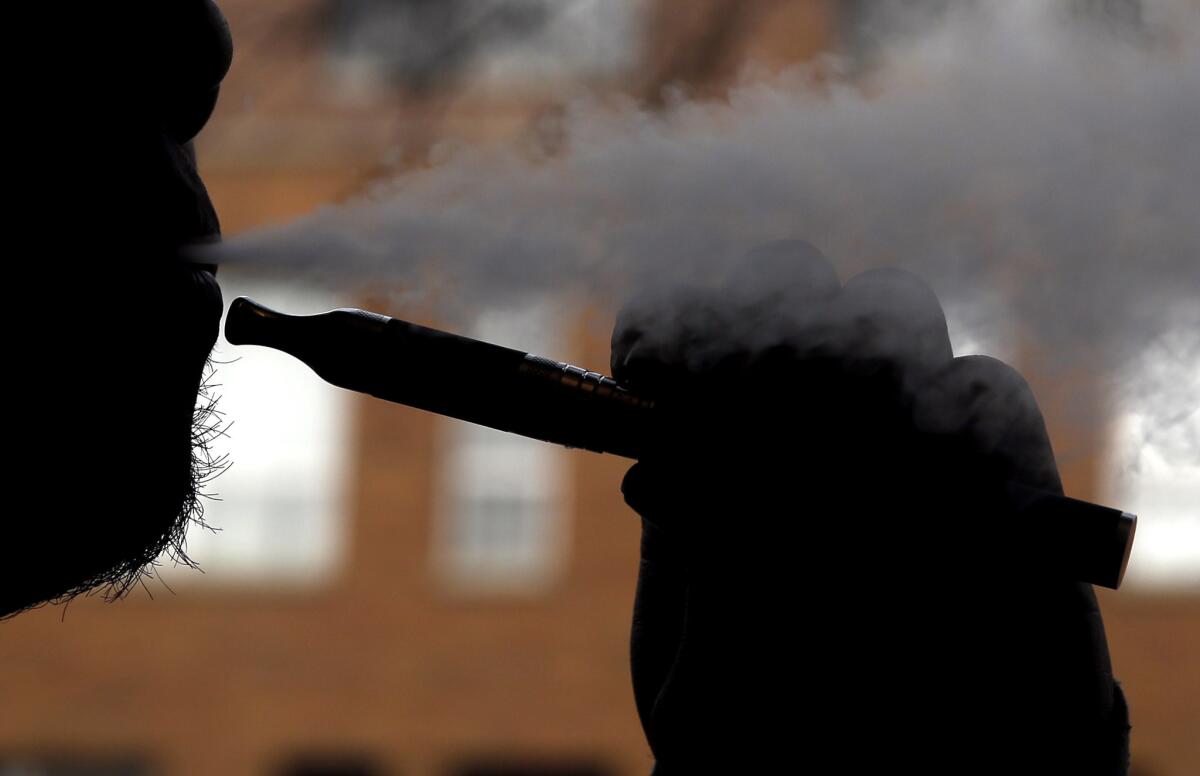FAQ: Deadly lung illnesses tied to vaping rise. What we know

To vape or not to vape? That is the question.
Once touted as a safer alternative to smoking, vaping has now been linked to lung illnesses that have landed hundreds of people in hospitals, killing several in recent months.
Federal officials said Thursday afternoon that nearly 1,300 people had been diagnosed with a vaping-related lung disease since March. The outbreak’s youngest fatality, a 17-year-old who lived in the Bronx, was announced earlier this week.
Health officials across the nation are are telling people to refrain entirely from vaping, whether marijuana or nicotine. Los Angeles officials this week began considering banning all e-cigarettes and vaping devices. Los Angeles County already banned flavored e-cigarettes, as have multiple states.
But with new information coming out each week, the messaging has gotten a little messy. Here’s some information to help sort it out.
So what’s going on?
As of Oct. 8, 1,299 people who have a history of vaping have been diagnosed with some type of serious lung injury, such as severe breathing problems or lung damage. Twenty-six people have died, including three in California.
Officials say the lung problems do not appear to be caused by an infection but are likely the result of vaping itself or of inhaling a chemical while vaping. The patients’ symptoms include shortness of breath, chest pain, nausea and fever, among others.
The outbreak has hit young people particularly hard, with 80% of those sick younger than 35, according to the U.S. Centers for Disease Control and Prevention. The median age of the patients who have died is about 50, officials say.
What do I need to stay away from?
Health officials are advising that people avoid using vaping devices of all kinds, whether loaded with nicotine or THC from marijuana. Signs, however, increasingly point to THC as the culprit.
A recent analysis of 573 lung-injury patients nationwide found that 76% had used THC, compared with 13% who had used only nicotine.
When health officials from Wisconsin and Illinois interviewed 86 people in their states who had become ill, almost everyone said he or she had acquired their THC cartridges illegally — either from friends, family members or drug dealers. Two-thirds said they had used the same brand.
“In Wisconsin, two groups of friends ... who became ill after using THC-containing cartridges specifically reported sharing Dank Vapes cartridges. Dank Vapes was the only e-cigarette product reported by one of the patients,” according to the report from the two states.
Still, CDC principal deputy director Anne Schuchat said in a call with reporters last week that it was too soon to narrow their investigation to marijuana or a specific product. The source of the problems could vary across the country, she said.
“There might be a lot of different, nasty things in e-cigarette or vaping products,” Schuchat said. “There is a lot of conversation out there about what is and isn’t safe. Personally, with all the data that I have been seeing, I don’t know what is safe is right now.”
Does this mean e-cigarettes are now more dangerous than cigarettes?
No. Health experts say cigarettes are still worse for you than e-cigarettes.
UC San Francisco tobacco researcher Pamela Ling said that if her patients want to quit smoking by switching to e-cigarettes, she will support them because the devices remain preferable to cigarettes.
“But I try to get them to set a quit date with the e-cigarettes as well,” she said.
Some public health advocates have raised concerns that restricting e-cigarette access will push former smokers back to cigarettes. CDC officials said that smokers who now rely on e-cigarettes should talk to their doctors about switching to FDA-approved smoking cessation devices.
“We really don’t want people to return to smoking cigarettes,” Schuchat said.
In the United States each year, 480,000 people die from illnesses caused by cigarettes, accounting for about one-fifth of all deaths nationwide, according to the CDC.
Have there been any changes to the law that affect my ability to vape or use e-cigarettes?
If you live in California and are at least 21 years old, you can still buy marijuana and e-cigarette products — for now.
San Francisco has banned all e-cigarettes and Beverly Hills has banned all tobacco products, but neither law has taken effect yet. Manhattan Beach is considering banning all tobacco products as well.
Another 40 cities and counties in the state have banned flavored tobacco products, which experts say attract young people to try nicotine, but unflavored e-cigarettes remain available, according to the Campaign for Tobacco-Free Kids.
In L.A. County, flavored e-cigarette products and menthol cigarettes will be outlawed starting Oct. 31. The restriction will apply only to unincorpated parts of the county, home to 1 million people.
Outside of California, Massachusetts has instated a four-month ban on e-cigarettes and all vaping devices, and Michigan, Washington, New York and several other states and more than 100 other localities have moved to outlaw flavored e-cigarette products.
More to Read
Sign up for Essential California
The most important California stories and recommendations in your inbox every morning.
You may occasionally receive promotional content from the Los Angeles Times.











